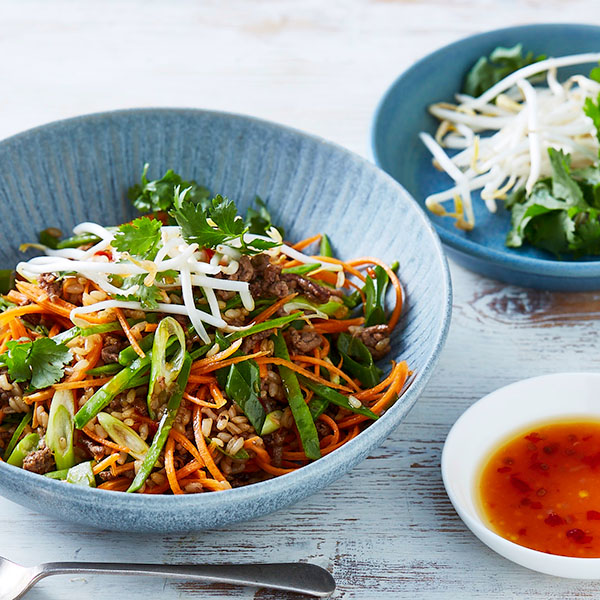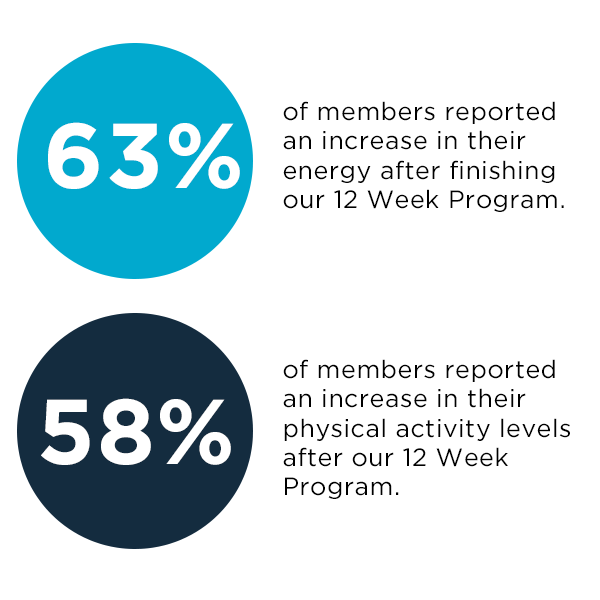How Better Diet Can Help Joint Pain
Osteoarthritis and back pain are the most common joint-related complaints in Australia. Around 2.2 million Australians suffer from osteoarthritis1, and being overweight or obese is a major risk factor for joint pain.
The good news is that losing a modest amount of weight and making simple lifestyle changes can have a big impact on your pain.
In fact, losing as little as five percent of your body weight can offer significant health benefits, including managing symptoms of osteoarthritis and joint pain.
This is where the CSIRO Total Wellbeing Diet comes in!
A diet plan designed for joint pain
The Total Wellbeing Diet is designed to help you eat better, lose weight, gain back your energy, and break free of joint pain for good. Excess weight can add stress to joints such as your back, knees, and feet. With proper diet and exercise
When you join, you will gain access to:
- A scientifically formulated weight loss plan from the CSIRO
- Easy and delicious high protein, low GI recipes to help combat joint pain
- Educational content and special advice on how to manage pain in joints
- Useful online tracking tools so you can watch your body change
- Access to our Android & iOS companion app
- Simple exercises you can do at home to alleviate joint pain
- A supportive online community to keep you motivated
- A refund^ of $199 on selected plans

What to expect when you join
The CSIRO Total Wellbeing Diet is a higher protein, low GI eating plan that has been created and tested by Australia’s national science agency, the CSIRO.
The latest research emphasises that weight loss and avoiding weight gain are the most effective methods to improve osteoarthritis and joint pain.
By joining our online program you can improve your eating habits, lose weight, reduce your joint pain, and gain back your energy.
Citation: Hendrie & Williams. CSIRO Total Wellbeing Diet Online: Member Survey. Understanding the health impacts of the program. CSIRO. 2019.
Join now
Jennifer is now pain free
A back injury and daily aches and pains in her joints meant Jennifer wasn't able to play with her grandsons. She joined the CSIRO Total Wellbeing Diet, lost an impressive 23 kg* and is now able to keep up with her grandkids and go on long walks and bike rides with her husband.
*in 12 months. Individual results may vary.
Join nowKerri got back to her exercise routine
After being diagnosed with two forms of arthritis, Kerri knew she needed to lose weight to manage her health issues. She lost 27 kg*, allowing her to get back to an exercise routine that helped manage her symptoms and reduced pressure on her joints.
*in 45 weeks. Individual results may vary.
Join nowJanice feels 10 years younger and lighter
“My foot just cracked under the pressure! My hips and knee joints were always sore and it was harder and harder to just stand up after sitting for a while.” After losing 19.7 kg*, Janice's joints are no longer sore and she can easily get up and down from sitting.
*in 26 weeks. Individual results may vary.
Join now1Australian Bureau of Statistics (ABS) 2017–18 National Health Survey (NHS)

Want to learn more about how our program can help with joint pain?
Enter your name and email here and we'll send you everything you need to know about the CSIRO Total Wellbeing Diet.Frequently asked questions
How do I get the Joint Pain program?
Simply sign up to the CSIRO Total Wellbeing Diet by clicking here. When you login to your account for the first time, you'll guided through the initial setup and be prompted to choose a program preference. This is where you can indicate you would like to follow the program for Joint Pain.
Will my health fund help pay for the Total Wellbeing Diet?
Very possibly! We have partnerships with many of the top health funds in Australia, allowing members to claim back the cost of the membership under their Extras or Hospital Cover. Click through to find out if you're eligible to get our program rebated - or in some cases completely free of charge.
What is osteoarthritis and joint pain?
Joints form the connections between bones. Any damage to them – from either disease or injury – can interfere with movement and cause discomfort.
Joint pain usually builds up over several years when the cartilage becomes brittle, so the joints can no longer move smoothly or easily.
There are many conditions that can lead to painful joints, such as osteoarthritis, rheumatoid arthritis, bursitis, gout, strains, sprains, and other injuries.
Osteoarthritis, which affects one in 11 Australians, is a chronic condition caused by worn down cartilage in the joints.
This causes the bones to rub together resulting in its painful symptoms. It largely affects the hands, spine, hips, knees and ankles.
How does weight gain cause joint pain?
Weight gain can cause joint pain because excessive weight puts added stress on weight-bearing joints, such as the hips, knees, and ankles. When you carry extra weight, your joints have to work harder to support your body, which can lead to increased wear and tear on the joints over time. This can result in joint pain, stiffness, and inflammation.
Carrying extra weight can also make existing joint problems worse. For example, if you have knee pain due to a previous injury, carrying excess weight can exacerbate the pain and increase the risk of further damage to the knee.
Does joint pain go away after weight loss?
Your weight is of particular importance when it comes to your risk of joint pain, as well as in the management of the condition once you have it. It is estimated that 50 per cent of people develop OA due to being overweight or obese, and given nearly two-thirds of Australian adults are just that – that’s a whole lot of people at risk of achy joints. Indeed, being overweight or obese is the single most important risk factor for knee OA – people who are obese are twice as likely to develop OA in the knee compared to people who aren’t.
There are many benefits of weight loss for hip and knee OA in particular, with international guidelines recommending weight loss as a core treatment. Consider this: it’s estimated that every kilo of excess weight we carry puts an extra load of four kilos on our knee joints. So it makes sense that losing even a small amount of weight can help relieve pressure on your joints, reduce pain and assist in preventing further damage.
How do I prevent joint pain from weight gain?
Rest assured, you’re in the right place. Stick with the meal plans and incorporate grains, fruits and vegetables into as many meals as possible. Eat low-fat dairy and eggs, enjoy fish at least twice a week and limit foods high in saturated fat, salt and sugar. And enjoy regular exercise – such as walking (try using Nordic poles to help make walking easier and more enjoyable), cycling and swimming – which can increase your endurance and strengthen the muscles around your joints (and make you feel good too).
What foods should I avoid for joint pain?
Keeping off excess weight is a priority for those suffering from chronic joint pain, so ditching the obvious offenders – such as food high in sugars, saturated fats and unhealthy oils – is key. You can also reduce foods that may contribute to inflammation. Really try to reduce the following:
- Refined carbohydrates. Highly refined, highly processed carbohydrates in snack foods and baked foods should be limited as they usually come with additional sugar, salt, and fat. And where possible, high glycemic index foods such as white flour based-products (like white bread), and white rice, and many processed cereals should be swapped for wholegrain varieties such as wholemeal bread, brown rice and less processed cereals.
- Alcohol. Experts recommend no more than two standard drinks a day. However, you could only drink a maximum of 7 standard drinks a week on TWD, i.e. 1 a day, assuming you eat no other indulgences which is probably not realistic. Alcohol is considered an indulgence and comes from your allowance of indulgence or discretionary foods. It’s best to limit alcohol or omit it altogether.
- Processed foods. Processed foods are often high in saturated fat and sugar too. So go fresh wherever possible!
- Salt. It’s not just the salt you add at the dinner table – a lot of the salt in our diet comes from processed foods, even ones like bread and cereal that you wouldn’t necessarily consider ‘salty’. Look for products which are labelled with “No Salt”, “Low Salt” or “Reduced Salt” and check the ingredients list. Try to choose low salt foods which have less than 120mg of sodium per 100g of product. Consume foods with less than 400mg of sodium per 100g occasionally. Avoid foods with more than 400mg of sodium per 100g.
What foods are best for joint pain?
While there is no ‘miracle food’ that can cure OA and other joint pain, it can certainly help to eat a well-balanced diet and anything packed with inflammation-fighting, bone-strengthening and immune boosting properties, which means fuelling up on omega-3 fatty acids, healthy fats, vitamin D and calcium. Sticking to your food units, ramp up staples like:
- Fish and lean proteins. Look to oily varieties – such as salmon, tuna or mackerel – twice a week. People often take fish oil supplements to help alleviate symptoms of osteoarthritis and joint pain, but there is limited evidence to show they work. They can have an anti-inflammatory effect, but only in patients with rheumatoid arthritis - not osteoarthritis.
- Fruits and vegetables. The Total Wellbeing Diet program contains a wide variety of antioxidant-rich fruits and vegetables, which can help reduce joint pain. Don’t be shy when it comes to loading up your plate with ‘free’ vegetables like leafy green spinach and broccoli!
- Olive oil over vegetable oil. It’s packed with oleocanthal, which shares similar properties to non-steroidal, anti-inflammatory drugs.
- Low-fat dairy products over higher-fat equivalents. Low-fat milk, yoghurt and cheeses are great sources of bone-strengthening calcium as well as a little vitamin D.
I have multiple health issues, including joint pain, which program is best for me?
If you're experiencing multiple health issues such as high blood pressure, joint pain, high cholesterol, etc, choose the one you would like to focus the most on.
If this is joint pain rest assured that our program is tailored to you.
The CSIRO Total Wellbeing Diet is a higher protein, low GI eating plan that has been created and tested by Australia’s national science agency, the CSIRO.
The latest research emphasises that weight loss and avoiding gaining weight are the most effective methods to improve osteoarthritis and joint pain.
By joining our online program, you can lose weight, reduce your joint pain, and gain back your energy!
Do I need a doctor’s referral?
No, you do not need a referral from your doctor to join the CSIRO Total Wellbeing Diet.